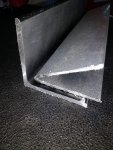Thanks for your interest, hope this info helps you build your own creation. As for what I have discovered; I'd say the panels have exceeded my expectations. By this I mean insulation factor. I wanted a camper that would provide comfort and protection in any climate. My first camper was a Tiger Bengal. While the family enjoyed it, I was not happy with the R value. So when I had my next camper custom made by Phoenix, I requested 2" foam walls and 4 ply fabric in the pop up. This too did not provide the R value I was after, not to mention the condensation battle in cold temps. Panel built rigs are essentially refrigeration boxes. It doesn't take much to maintain a desired temperature thus reducing energy usage. Second to the R value is no set up. We can pull up, crawl through the pass through and be protected in any weather. No pop up to pop or slide out to slide. Simple and self contained is what I discovered I like best.
If you have seen the latest models by FWC and AT overland "camper shells", you could easily do the same with panels. Just bolt down to existing truck bed, then build out the interior and insulate. Just a thought

Here is the response from post #265
My idea for a new panel has different variations. * Cost and weight. If you go with 2" foam board, you will need 4" aluminum angle which increases cost and weight. For 1" foam board, 3" aluminum angle which will decrease cost and weight. This will be a personal preference regarding wall thickness and R value.
Another weight factor is the FRP skin. The double woven is heavier than the single, maybe not by much, but it all adds up.
Cost of the high density foam board is, well, high. Is it really necessary to have high density or can it be achieved another way? Density comes more into play horizontally, while rigidity is more a vertical factor.
The following has not been tested yet. If I were to build another panel I would use all carbon nanotube epoxy. This stuff is strong and rigid. Next would be single weave FRP to save weight.
To save in cost I would use the pink foam board that is easily found at Home Depot or other hardware stores. Then I would lay out a grid on the foam board; for example 1' X 1', and drill a hole at each intersection with either a 3/8 " or 1/2" bit. Panel lamination would be 2 steps. 1'st laminate/epoxy foam to FRP and allow to cure. 2'nd fill the holes with epoxy/laminate other FRP skin.
The epoxy will not only provide rigidity but density too. If you look back at my first post, my first test was on regular 3/4 inch foam board using single weave FRP and non carbon nanotube epoxy. It was strong enough to support my weight of over 200lbs. I would think with the connecting bore holes filled with epoxy, added strength, rigidity, and density could be achieved at a lower price.
I would also look at vacuum bagging the panels or making some sort of jig that would allow placement of jacks to put pressure on the skin while curing.
So in conclusion, cost can be reduced by using regular foam board and weight can be reduced by using smaller aluminum angle and single weave FRP.


